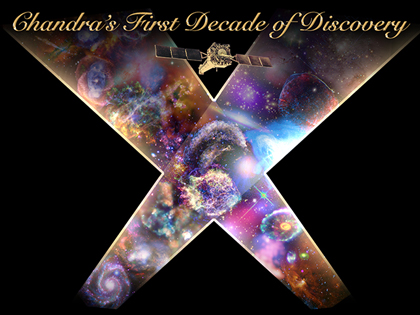New Vista of Milky Way Center Unveiled
A dramatic new vista of the center of the Milky Way galaxy from NASA's Chandra X-ray Observatory exposes new levels of the complexity and intrigue in the Galactic center. The mosaic of 88 Chandra pointings represents a freeze-frame of the spectacle of stellar evolution, from bright young stars to black holes, in a crowded, hostile environment dominated by a central, supermassive black hole.
Black Hole Pumps Iron
This composite image of the Hydra A galaxy cluster shows 10-million-degree gas observed by Chandra in blue and jets of radio emission observed by the Very Large Array in pink. Optical data (in yellow) from the Canada-France-Hawaii telescope and the Digitized Sky Survey shows galaxies in the cluster.
Hub of the Universe
Everyone around here knows that Boston likes to consider itself the "Hub of the Universe". This month, it really is. Opening this weekend, two outdoor exhibitions - at the Museum of Science and UMass-Boston – will help Bostonians explore their place in the cosmos.
Those of you who are regularly readers of the Chandra blog already have heard a great deal about this project. But for the rest of you, here's some background.

A previous stop of the traveling exhibit, in Washington DC
Back To School: Three Simple Ways to Share the Universe With Your Child
Parents can play an important part in helping their child explore the world around them. Space might seem far out there, but it can ignite your child's imagination — and can cause them to zip around your living room pretending to be a rocket among the outer planets.
We have developed a lot of educational Chandra activities and products to do just that (ignite your child's imagination that is, not send them to the outer planets!). Here are three easy things to try with your young child (ages 5-8) to bring a little bit of Chandra and the rest of the Universe right to them.

An Oldie But Goodie
Last week, we released the Chandra image of an object known as Cygnus X-1. At first glance, Cygnus X-1 might not look that important - even with Chandra's excellent X-ray vision - but this is one case where it's good not to judge a book by its cover.
TEN YEARS AFTER THE FIRST
Ten years ago tomorrow (August 26th), the official First Light image from Chandra was released to the world. The image was of the famous supernova remnant Cassiopeia A, taken less than a month after Chandra was deployed by the Space Shuttle Columbia.

Snapshots of Cassiopeia A
Cepheus B: Trigger-Happy Star Formation
This composite image of X-rays from Chandra (violet) and infrared data from Spitzer (red, green, and blue) reveals a beautiful scene of star formation within our Galaxy. There are hundreds of very young stars inside and around the cloud -- ranging from a few millions years old outside the cloud to less than a million in the interior -- making it an important testing ground for star formation. By combining the data from these two observatories, researchers have shown that radiation from massive stars may trigger the formation of many more stars than previously thought.
AT THE COPA, COPACABANA
OK, technically speaking, this week's International Astronomical Union (IAU) meeting is not on the beach in Copacabana, but it is in Rio de Janeiro. Most of the attendees are staying at hotels in the made-famous-by-Barry-Manilow section of Rio, but the conference is really being held at the Sul America Convention Center (see picture) in the central part of the city. (The alternate headline for this post was going to be "The Girl from Ipanema" so maybe the one being used now seems a little less cheesy by comparison.)

Ten Years Later
It's been ten years since Chandra was launched. A decade is a long time for a spacecraft, or any other complex machine, to operate without maintenance. Hubble has been up 18 years (launch 1991), but it has had regular maintenance with five Space Shuttle crews putting in new instruments and replacing worn out old parts. Chandra, on the other hand, was deliberately placed where the Shuttle couldn't service it. So Chandra's not doing badly considering there will be no 200-million-mile/10-year tune up!
Adding a New Dimension to an Old Explosion
This image of the debris of an exploded star - known as supernova remnant 1E 0102.2-7219, or "E0102" for short - features data from NASA's Chandra X-ray Observatory. E0102 is located about 190,000 light years away in the Small Magellanic Cloud, one of the nearest galaxies to the Milky Way. It was created when a star that was much more massive than the Sun exploded, an event that would have been visible from the Southern Hemisphere of the Earth over 1000 years ago.






